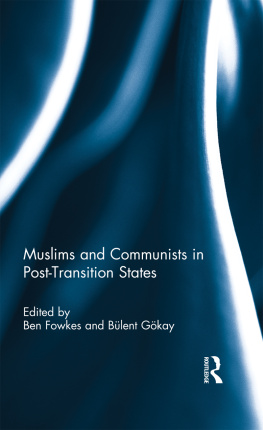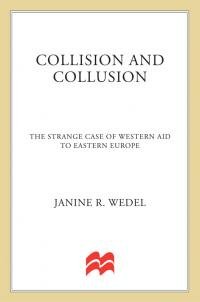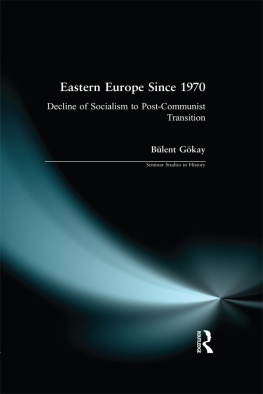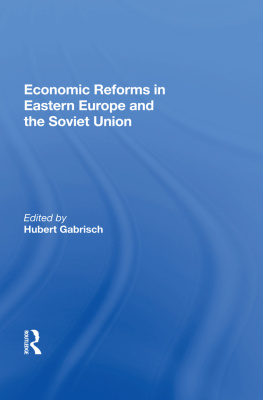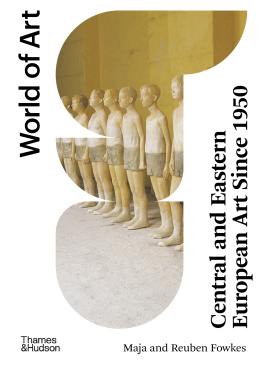Eastern Europe 19451969:
From Stalinism to Stagnation
SEMINAR STUDIES IN HISTORY
Eastern Europe 19451969:
From Stalinism to Stagnation
BEN FOWKES
First published 2000 by Pearson Education Limited
Published 2013 by Routledge
2 Park Square, Milton Park, Abingdon, Oxon OX14 4RN
711 Third Avenue, New York, NY 10017, USA
Routledge is an imprint of the Taylor & Francis Group, an informa business
Copyright 2000, Taylor & Francis.
The right of Ben Fowkes to be identified as author of this work has been asserted by him in accordance with the Copyright, Designs and Patents Act 1988.
All rights reserved. No part of this book may be reprinted or reproduced or utilised in any form or by any electronic, mechanical, or other means, now known or hereafter invented, including photocopying and recording, or in any information storage or retrieval system, without permission in writing from the publishers.
Notices
Knowledge and best practice in this field are constantly changing. As new research and experience broaden our understanding, changes in research methods, professional practices, or medical treatment may become necessary.
Practitioners and researchers must always rely on their own experience and knowledge in evaluating and using any information, methods, compounds, or experiments described herein. In using such information or methods they should be mindful of their own safety and the safety of others, including parties for whom they have a professional responsibility.
To the fullest extent of the law, neither the Publisher nor the authors, contributors, or editors, assume any liability for any injury and/or damage to persons or property as a matter of products liability, negligence or otherwise, or from any use or operation of any methods, products, instructions, or ideas contained in the material herein.
ISBN: 978-0-582-32693-4 (pbk)
British Library Cataloguing-in-Publication Data
A catalogue record for this book is available from the British Library
Library of Congress Cataloging-in-Publication Data
Fowkes, Ben.
Eastern Europe 1945-1969: From Stalinism to Stagnation / Frank Benjamin Michael Fowkes.
p. cm. (Seminar studies in history)
Includes bibliographical references and index.
ISBN 0-582-32693-1 (ppr)
1. Europe, EasternPoiitics and government-19451989.I. Title. II. Series.
DJK50 .F69 2000
320.947--dc21
99-089001
Such is the pace of historical enquiry in the modern world that there is an ever-widening gap between the specialist article or monograph, incorporating the results of current research, and general surveys, which inevitably become out of date. Seminar Studies in History are designed to bridge this gap. The series was founded by Patrick Richardson in 1966 and his aim was to cover major themes in British, European and World history. Between 1980 and 1996 Roger Lockyer continued his work, before handing the editorship over to Clive Emsley and Gordon Martel. Clive Emsley is Professor of History at the Open University, while Gordon Martel is Professor of International History at the University of Northern British Columbia, Canada and Senior Research Fellow at De Montfort University.
All the books are written by experts in their field who are not only familiar with the latest research but have often contributed to it. They are frequently revised, in order to take account of new information and interpretations. They provide a selection of documents to illustrate major themes and provoke discussion, and also a guide to further reading. The aim of Seminar Studies is to clarify complex issues without over-simplifying them, and to stimulate readers into deepening their knowledge and understanding of major themes and topics.
Readers should note that numbers in square brackets [] refers readers to the corresponding item in the Documents section which follows the main text. Asterisks mark items listed in the Glossary.
Eastern Europe is defined in this book as the part of Europe which came under communist rule after the Second World War. This definition is historical rather than geographical. It expresses the reality that over the whole of the area from the Baltic to the Adriatic, from the River Elbe to the Rhodope Mountains, the methods and objectives of communist rule, and the impact of communism on nations and societies, were practically identical. This fact served very quickly to mark off these countries as a whole from the West. This is why Greece is never, and Bulgaria always, regarded as part of Eastern Europe. Admittedly, the definition is fuzzy at the edges. East Germany ought perhaps to be excluded (it often has been by writers on this subject). Perhaps the Baltic countries of Estonia, Latvia and Lithuania deserve inclusion. But they were directly incorporated into the Soviet Union rather than being given the relative independence from which the rest of Eastern Europe benefited after 1945. Moreover, the story of the three that got away Finland, Austria and Greece is possibly also relevant, as it throws light on communist techniques of achieving power and reasons for failure, as well as on Stalins postwar strategic options.
Despite these hesitations, we shall concentrate here on the central bloc of satellite states, Europe of the Eight, namely East Germany (known officially after 1949 as the German Democratic Republic, before that as the Soviet Occupation Zone, or SBZ); Czechoslovakia; Poland; Hungary; Romania; Bulgaria; Yugoslavia; and Albania. These are the European countries that passed under communist control between 1944 and 1948 and remained in that situation for the next forty or so years. Differences in development and culture will also sometimes compel us to view Eastern Europe as composed of two parts, namely East Central and South Eastern Europe, divided by a line running to the east and south of Hungary. The topic, too, has been divided into two parts: before and after 1969. This book is the first part. It covers the seizure of power, the period of Stalinism and subsequent attempts at reform within the system. The period of decline after 1969 is dealt with in a companion volume by Dr Blent Gkay.
The publishers are grateful to the following for permission to use copyright material:
Photograph 1 Sceptical East German workers listen to Fritz Selbmann, GDR Minister of Heavy Industry, opening a coke and lignite works, 31 August 1955 from Anatomy of a Dictatorship: Inside the GDR 19491989, pp. 1489, Oxford University Press, permission sought from SED Bildarchiv, Berlin (Fulbrook, 1995)
Photograph 2 Communists demonstrate in Belgrade promising the doubling of wheat production in 1947, dominated by Titos picture from Yugoslavia as History, p. 244, Cambridge University Press, used with permission from the Museum of the City of Belgrade (Lampe, 1996)
Photograph 3 The female student militia on parade in Tirana, 1964 from The Albanians: Europes Forgotten Survivors, pp. 1045, Victor Golanz, used with permission from D. Logoreci (Logoreci, 1977)
Photograph 4 Tito in discussion with his two chief lieutenants, Eduard Kardelj and Aleksander Rankovic, at some time during the mid-1960s from


